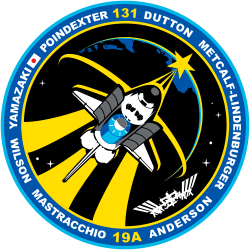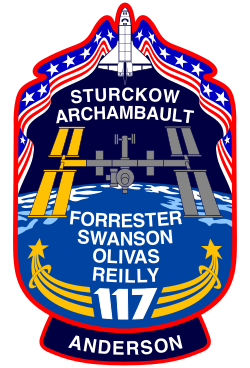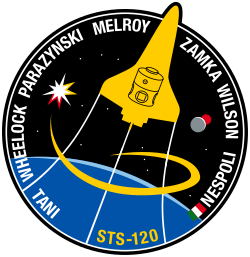Clayton Anderson
| Clayton Conrad Anderson | |
 | |
| Född | 23 februari 1959 Omaha, Nebraska |
|---|---|
| Andra yrken | NASA-astronaut |
| Tid i rymden | 166 dagar, 21 timmar, 10 minuter |
| Urvalsgrupp | Astronautgrupp 17 |
| Antal rymdpromenader | 6 st |
| Rymdpromenadtid | 38 timmar, 28 minuter |
| Uppdrag | STS-117, Expedition 15/16, STS-120, STS-131 |
| Uppdragsemblem | |
Clayton C. Anderson, född 23 februari 1959 i Omaha, Nebraska, är en amerikansk astronaut uttagen i astronautgrupp 17 den 4 juni 1998.
Familjeliv
Clayton Anderson är gift och tillsammans har de två barn Clayton “Cole” och dottern Sutton Marie.
Karriär
Anderson började arbeta på Nasa 1983 som tekniker på olika nivåer, men i juni 1998 blev han utvald att påbörja sin grundutbildning till uppdragsspecialist. I augusti samma år påbörjade han utbildningen. Under utbildningen genomförde han även en intensivutbildning i rymdfärjans och rymdstationens olika system samt psyklogiskt träning.
Han har varit reservbesättning för ISS-besättning 12, 13 och 14.
Rymdfärder
- Upp med Atlantis - STS-117 den 8 juni 2007.
- Expedition 15
- Expedition 16
- Hem med Discovery - STS-120
- Discovery - STS-131
Källor
”Biographical Data” (på engelska) (PDF). NASA. januari 2013. https://www.nasa.gov/wp-content/uploads/2016/01/anderson_clayton.pdf?emrc=ef3627. Läst 5 maj 2024.
|
Media som används på denna webbplats
This patch commemorates the sixteenth expeditionary mission to the International Space Station (ISS). The design represents the conjunction of two unique astronomical events: a transit of the ISS across the surface of a full moon, and a nearly complete annular eclipse of the sun. The ISS is shown in its complete configuration, symbolizing the role of this expedition in preparing for the arrival and commissioning of international partner modules and components. The ISS transit across the moon highlights its role in developing the techniques and innovations critical to enable long-duration expeditions to the lunar surface and beyond.
The STS-131/19A crew patch highlights the Space Shuttle in the Rendezvous Pitch Maneuver (RPM). This maneuver is heavily photographed by the International Space Station (ISS) astronauts, and the photos are analyzed back on earth to clear the Space Shuttle's thermal protection system for re-entry. The RPM illustrates the teamwork and safety process behind each Space Shuttle launch. In the Space Shuttle's cargo bay is the Multi-Purpose Logistics Module (MPLM), Leonardo, which is carrying several science racks, the last of the four crew quarters, and supplies for the ISS. Out of view and directly behind the MPLM, is the Ammonia Tank Assembly (ATA) that will be used to replace the current ATA. This will take place during three Extra Vehicular Activities (EVAs). The 51.6° Space Shuttle orbit is illustrated by the three gold bars of the astronaut symbol, and its elliptical wreath contains the orbit of the ISS. The star atop the astronaut symbol is the dawning sun, which is spreading its early light across the Earth. The background star field contains seven stars, one for each crewmember; they are proud to represent the United States and Japan during this mission.
The operational teamwork between human space flight controllers and the on-orbit crew take center stage in this emblem. Against a backdrop familiar to all flight controllers, past and present, independent of any nationality, the fifteenth expedition to the ISS is represented in Roman numeral form as part of the ground track traces emblazoned on the Mercator projection of the home planet Earth. The ISS, shown in its fully operational, assembly complete configuration, unfurls and then reunites the flags of this Russian and American crew in a show of our continuing international cooperation. Golden spheres placed strategically on the ground track near the flight control centers of the United States and Russia serve to symbolize both the joint efforts from each nation's team of flight controllers and the shuttle and Soyuz crew vehicles in their chase orbit as they rendezvous with the ISS. A rising sun provides a classic touch to the emblem signifying the perpetual nature of manned space flight operations and their origin in these two space-faring nations.
The STS-117 crew patch symbolizes the continued construction of the International Space Station (ISS) and our ongoing human presence in space. The ISS is shown orbiting high above the Earth. Gold is used to highlight the portion of the ISS that will be installed by the STS-117 crew. It consists of the second starboard truss section, S3/S4, and a set of solar arrays. The names of the STS-117 crew are located above and below the orbiting outpost. The two gold astronaut office symbols, emanating from the '117' at the bottom of the patch represent the concerted efforts of the shuttle and station programs toward the completion of the station. The orbiter and unfurled banner of red, white and blue represent our Nation's renewed patriotism as we continue to explore the universe.
The STS-120 patch reflects the role of the mission in the future of the space program. The shuttle payload bay carries Node 2, the doorway to the future international laboratory elements on the International Space Station. On the left the star represents the International Space Station; the red colored points represent the current location of the P6 solar array, furled and awaiting relocation when the crew arrives. During the mission, the crew will move P6 to its final home at the end of the port truss. The gold points represent the P6 solar array in its new location, unfurled and producing power for science and life support. On the right, the moon and Mars can be seen representing the future of NASA. The constellation Orion rises in the background, symbolizing NASA's new exploration vehicle. Through all, the shuttle rises up and away, leading the way to the future.





